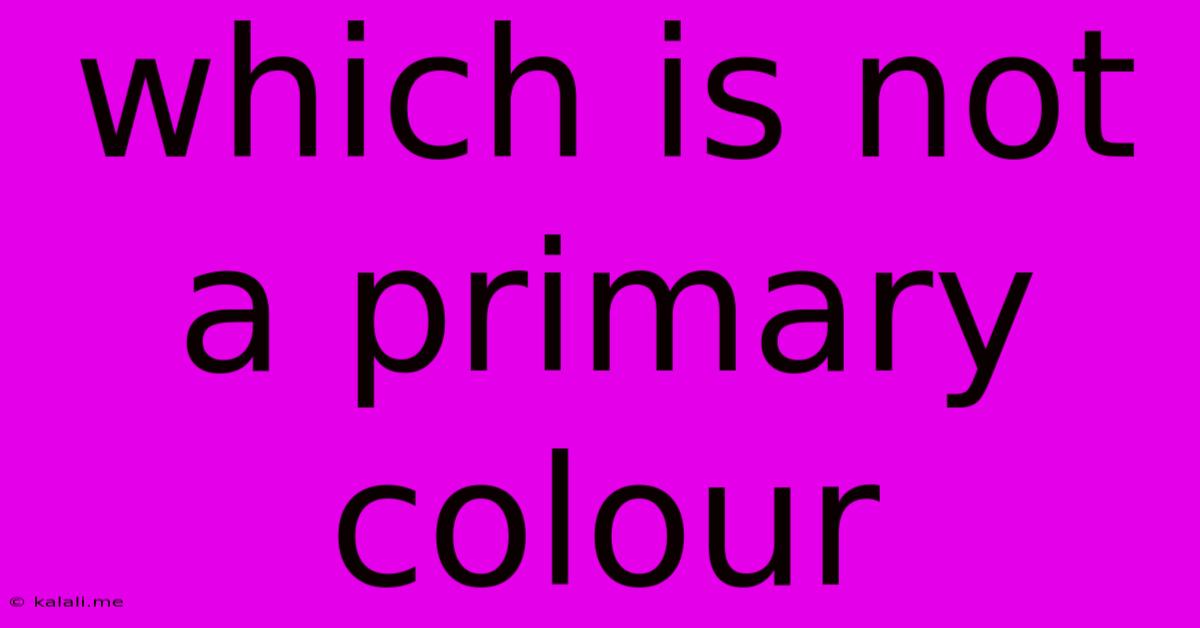Which Is Not A Primary Colour
Kalali
Jun 14, 2025 · 2 min read

Table of Contents
Which is Not a Primary Color? Understanding Primary, Secondary, and Tertiary Colors
This article will explore the concept of primary colors, clarifying which colors are not considered primary and delving into the relationships between primary, secondary, and tertiary colors. Understanding this foundational aspect of color theory is crucial for artists, designers, and anyone working with visuals. We'll cover the basics and offer examples to solidify your understanding.
What are Primary Colors?
Primary colors are the fundamental hues from which all other colors can be derived by mixing. They cannot be created by mixing other colors together. In the most common color model, the additive color model used in light (like on computer screens), the primary colors are red, green, and blue (RGB). These colors, when combined at full intensity, create white light.
Which Colors are NOT Primary Colors?
Any color that can be created by mixing other colors is not a primary color. This includes a vast range of hues, but here are some key examples:
- Yellow: Yellow is a secondary color, created by mixing red and green.
- Cyan: Cyan is a secondary color, created by mixing green and blue.
- Magenta: Magenta is a secondary color, created by mixing red and blue.
- Brown: Brown is a tertiary color, a mixture of various other colors.
- Orange: Orange is a secondary color, often described as a mix of red and yellow. Note: While red and yellow appear to make orange in the subtractive color model (paints), the exact process is more nuanced.
- Purple/Violet: Purple or violet is a secondary color, created by mixing red and blue.
Understanding Secondary and Tertiary Colors
Once you understand primary colors, it's easier to grasp secondary and tertiary colors.
-
Secondary Colors: These colors are created by mixing two primary colors in equal proportions. As mentioned above, yellow, cyan, and magenta are examples of secondary colors.
-
Tertiary Colors: These colors result from mixing a primary color with an adjacent secondary color. Examples include red-orange, yellow-orange, yellow-green, blue-green, blue-violet, and red-violet. There are a wide array of subtle variations within these tertiary colors.
The Importance of Color Models
It's important to remember that the concept of primary colors can slightly vary depending on the color model. The subtractive color model (used in printing with cyan, magenta, yellow, and black – CMYK) has a slightly different set of primary colors. While the underlying principles remain similar, the specific colors and their interactions differ.
Conclusion
Understanding which colors are not primary colors involves comprehending the fundamental relationships between colors and how they interact to create a vast spectrum of hues. By mastering the concepts of primary, secondary, and tertiary colors, you'll gain a deeper appreciation for color theory and its applications in art, design, and other visual fields. Remember, the key takeaway is that any color created by mixing others is, by definition, not a primary color.
Latest Posts
Latest Posts
-
Least Common Multiple Of 4 8 And 12
Jun 15, 2025
-
Difference Between A Square And Rhombus
Jun 15, 2025
-
Unit Weight Of Water In Kg M3
Jun 15, 2025
-
How To Balance Chemical Equations Calculator
Jun 15, 2025
-
Which Of The Following Describes Transpiration
Jun 15, 2025
Related Post
Thank you for visiting our website which covers about Which Is Not A Primary Colour . We hope the information provided has been useful to you. Feel free to contact us if you have any questions or need further assistance. See you next time and don't miss to bookmark.